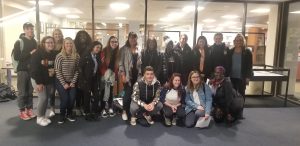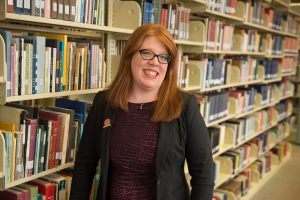As part of National Library Week 2019, Milner Library is profiling engaging opportunities available to the Illinois State University community.
The Dr. Jo Ann Rayfield Archives at Illinois State University houses thousands of items and documents telling the history of our campus. During this Spring 2019 semester, Archives partnered with several different classes to expose students to the resources of the archives. The head of the department, April Anderson-Zorn, has been travelling to different classes, bringing documents, and helping them put together exhibits with materials from the archives. Some of the classes she visited are Associate Professor Richard Hughes’ U.S. in the 20th Century Since 1945, Assistant Professor Lauren Bratslavsky’s Broadcast History, and Professor Alicia Wodika’s Community Public Health.
Anderson-Zorn said that the students are excited but intimidated to work with the materials, because they are afraid of hurting the material. “But, once we get them handling the materials and engaging with them, their brain kicks in with questions,” she said. “It goes pretty quickly from a sense of intimidation to one of curiosity and then excitement as they find answers to their questions while holding an old document.”
She continues to say that it’s important that these materials are brought to classes because undergrads don’t often have the opportunity to work with original material. They usually work with online resources, not the physical copies.
Both Bratslavky’s and Hughes’s class focused on the “flagpole incident” from the 1970s. Both were exposed to a recently donated collection of letters from a person who was on campus during the time of the incident.
The incident revolved around protests from students about the Vietnam War, and for who and when the flag on campus would be lowered to half-staff.
Bratslavky’s class on the history of broadcast met with Anderson-Zorn on March 28 to get their first taste of working with the collection. She brought old editions of the Vidette, papers from WZND, presidential papers, and papers from the School of Communication, all dating to the 1970s, to provide context for the incident.
“We are so used to having everything available on the internet, including me, that it is important to be constantly reminded that physical material still exists and there are reasons why everything is not digitized and accessible on the web,” Bratslavky said.
One thing she hoped was for her students to gain some understanding of their campus through old documents. Some discovered how little their RSOs changed over the years, while others noticed the differing opinions of the same events from the student perspective and other’s.
“If you touch history, you’re a part of history.” – April Anderson-Zorn
“I think it’s a valuable experience to flip through records from the past, to hold the papers, to see how people typed letters or what information is found, and not found, in the minutes of a meeting,” Bratslavsky said.
Anderson-Zorn also partnered with Wodika’s class on community and public health. Having met previously, Wodika knew Anderson-Zorn would be the ideal person to work with to bring the student’s projects to life.
“I loved the idea of getting students hands-on experience,” she said. “April was the first person I thought of working with because I knew she might have some great ideas for how to guide the students with the project.”
She continued, saying that Anderson-Zorn was patient when explaining the materials to the students “without overwhelming students.”
Wodika planned a project for her students to create exhibits for National Public Health Week that fell April 1-5 and the topics focused on public health on campus, including the beer riots in 1984, influenza on campus, and how ISU has approached sex ed. The class either had to create a physical exhibit of photos and captions or a slideshow. Both were displayed in the library, whether on the TVs on floor 3 or the stairwell on floor 2, from April 2 to May 7. At the beginning of class, most of the students considered making a slideshow for their project, but by the end of Anderson-Zorn’s crash course on exhibitions, a few flipped to exhibits.
The class itself opened up to a larger discussion where they bounced ideas off each other and asked questions on how to make their project more interesting and other items that would be beneficial to include.

Students enrolled in Health Sciences – Community Public Health course this semester created an exhibit on display at Milner Library.
Sophomore school health major Abby Bueter said that the archive’s materials aided her project because “it’s a wealth of super cool information about our university.” She said that she, like other students, probably would have never used the archives as an undergrad, as Anderson-Zorn echoed.
Bueter continued, saying that the archives are a resource that’s “going untapped, so I feel like doing this archives project is not only educating people on whatever project we picked but showing them that this information [at the archives] is available.”
At the beginning of the class, Anderson-Zorn told the students “If you touch history, you’re a part of history.” She says being in contact with history helps form an emotional connection between the artifact, the university, and the person.
“It’s the cool factor,” she said. “That makes for a stronger institution and a stronger Redbird community in that shared connection.”


